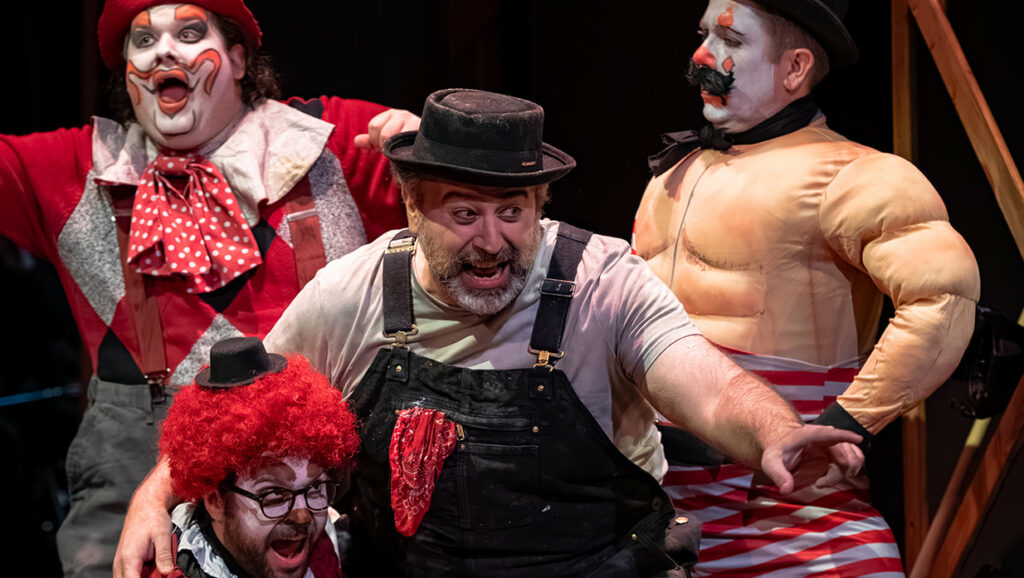Originally intended for the 2019-2020 season cut short by the Covid-19 pandemic, the staging now comes as the second installment of IN Series’s current season, which takes as its theme works that were censored at their debut. Verdi provides fertile material for reinterpretation by IN Series artistic director Timothy Nelson and head of music Emily Baltzer, who last season presented The Promised End, an overpowering mashup of the Verdi Requiem and King Lear inspired by the work of Harvard Shakespeare scholar Marjorie Garber. Many of the Rigoletto cast are veterans of that exhilarating production.
The circus is perhaps a natural setting for Rigoletto given the titular character’s career as a court jester. IN Series’s staging portrayed him as the big top’s cleaner with the Duke and courtiers as circus performers. This gave Rigoletto a sympathetic bent as the only civilian among a group of clowns, and the production convincingly conveyed his dehumanization on the path to revenge by having him later don the clown makeup himself. Yet by making the Duke a mime and instead investing control over the circus with the silent ringmaster, the production sacrifices one of the opera’s themes. In the original, the Duke of Mantua epitomizes the corrupt power figure who escapes consequences. Here, he’s just one of the gang.
This flattening of the Duke’s character suggests an interpretation of the opera as a broader indictment of society’s mistreatment of Rigoletto. Yet it was the critique of authority that resulted in Verdi’s opera running into trouble with the censors in the first place. The Victor Hugo play that inspired Rigoletto originally featured French King François I, later changed to the Duke of Mantua.
Bari Biern’s clever new translation of the libretto closely followed the contours of Francesco Maria Piave’s original text while accommodating snappy rhymes and a natural rhythm in English. For example, she adapted “La donna è mobile,” which is generally translated as “Woman is fickle,” instead as “Women are featherbrained,” fitting the music more closely. An alumna of the late Washington, DC political satire institution The Capitol Steps (which took its name from a South Carolina congressman’s early 1980s sex scandal that would not be out of character for Verdi’s Duke), Biern brought her impeccable sense of timing and wordplay to this Rigoletto.
This Rigoletto’s inventive musical adaptation scaled back the orchestra to a smaller ensemble featuring strings, woodwinds, and trombone, as well as an electronic circus organ. The infectious melodies of Verdi’s score shone under Baltzer’s zippy direction. The Act I music of the court of Mantua was a natural fit for the circus style, a lively reimagining that raised questions about the relationship between power, performance, and entertainment, though this approach was less effective in the score’s more tender moments between father and daughter.
Bass-baritone Chad Louwerse brought a rich, dark voice to Rigoletto, seamlessly transitioning in tone according to the emotional demands of the role as the story unfolded and easily filling the intimate space of the Edlavitch DC Jewish Community Center’s Aaron & Cecile Goldman Theatre. Act II revealed Louwerse at his best, showcasing his control over his instrument as he allowed anxiety to build in his concern for the missing Gilda before unleashing boiling rage.
In her role debut as Gilda, Teresa Ferrara’s bright soprano gave the character a compelling evolution from a warble of youthful innocence in Act I to a more steely resolve by Act III. Nelson gave Ferrara’s Gilda a Banksy-esque red balloon, underlining the immaturity and naïveté of the character and teeing up a helium-related soprano gag. Her and Louwerse’s chemistry lent a poignancy to their duets.
Rounding out the central triangle of characters, tenor Brian Arreola’s smooth-talking and bombastic take on the Duke exhibited his fluent command of his range. His “La donna è mobile” was all the more impressive for singing while simultaneously performing a juggling act. Arreola fearlessly rose to the occasion of singing the lines of Gilda’s nurse, Giovanna, comedically disguised with a mop-turned-wig and adopting an affected sour falsetto.
Bass-baritone Andrew Adelsberger dispatched the role of Sparafucile with cool, business-like efficiency, well-suited vocally to the role of the assassin. Double-casting was a feature of this stripped-down production, which also tasked Adelsberger with the challenging and atypical dual assignment of Sparafucile and Monterone, the grieving father who cast the curse on Rigoletto.
Baritone Henrique Carvalho and tenor Gregory Vladimir Sliskovich gave solid turns as the nobles Marullo and Borsa, respectively. Carvalho’s Marullo was deliciously gleeful in his betrayal of Rigoletto. All three singers capably shouldered the opera’s choral demands. Mezzo-soprano Elizabeth Mondragon provided supernumerary support to the chorus for the bulk of the opera as a leering ringmaster before singing Maddalena in Act III, which allowed IN Series to make use of her exquisitely dramatic presence throughout the opera rather than limit her to the denouement.
Nelson assigned the cast a complex array of Broadway-style choreography, a degree of physical exertion not often seen in opera but admirably executed without any signs of fatigue. The famous Act III quartet in particular was well blocked, effectively leveraging the close quarters of the Goldman Theatre. Donna Breslin’s costumes and Johnathan Dahm-Robertson’s set gave the production retro circus flair, while Paul Callahan’s lighting thoughtfully conveyed scene changes in the small space.
Nelson’s direction added a fresh visual sparkle to a well-trod opera, though some of the slapstick clown antics distracted from the singing at times. A few of this staging’s choices seemed to contribute more shock value than advance new interpretations of the work, such as the Cersei and Jaime Lannister treatment given to Sparafucile and Maddalena and a superfluously loud confetti cannon. These are small quibbles, however, and IN Series deserves credit for the high-wire act of reinterpreting a beloved classic.
Photos: Bayou Elom









Comments